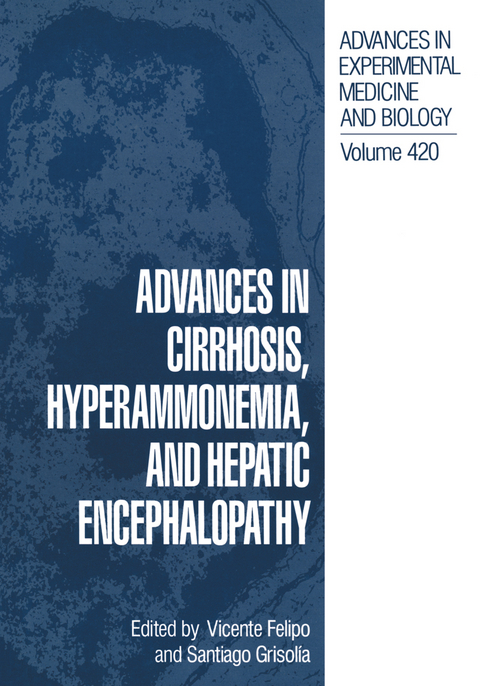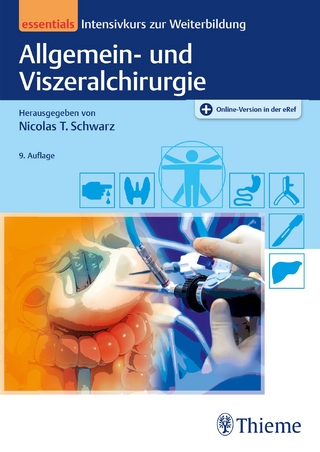
Advances in Cirrhosis, Hyperammonemia, and Hepatic Encephalopathy
Springer-Verlag New York Inc.
978-1-4613-7724-5 (ISBN)
This volume contains the papers presented at the International Symposium on "Cirrhosis, Hyperammonemia and Hepatic Encephalopathy," held in Valencia, Spain, De- cember 2nd_4th, 1996. Liver cirrhosis is one of the main causes of death in occidental countries. There are other hepatic dysfunctions such as fulminant hepatic failure, Reye's syndrome, or congenital deficiencies of urea cycle enzymes which can also lead to hepatic encephalopathy, coma and death. However, the molecular bases ofthe pathogenesis of hepatic encephalopathy remain unclear. One ofthe consequences of hepatic failure is the reduced ability to detoxify ammonia by incorporating it into urea. This leads to increased blood ammonia levels. Hyperam- monemia is considered one of the main factors responsible for the mediation of hepatic encephalopathy and classical clinical treatments are directed towards reducing blood ammo- nia levels. Altered neurotransmission is an essential step in the pathogenesis of hepatic encephalopathy. The first part of the book is devoted to the discussion of the recent advances in the understanding of the alterations of different neurotransmitter systems in hepatic encephalopathy.
The alterations of tryptophan metabolism and neurotransmission in hepatic encephalopathy and the implications for the clinical use of neuropsychoactive drugs are reviewed. The alterations in glutamate transport and neurotransmission in hepatic encephal- opathy due to acute liver failure are also reviewed. The role of NMDA receptors in the molecular mechanism of acute ammonia toxicity is discussed as well as its modulation by metabotropic glutamate receptors and muscarinic receptors.
Brain Tryptophan Perturbation in Hepatic Encephalopathy: Implications for Effects by Neuropsychoactive Drugs in Clinical Practice.- Hepatic Encephalopathy in Acute Liver Failure: Role of the Glutamate System.- Glutamate and Muscarinic Receptors in the Molecular Mechanisms of Acute Ammonia Toxicity and of Its Prevention.- Studies on the Pharmacological Properties of Oxindole (2-Hydroxyindole) and 5-Hydroxyindole: Are They Involved in Hepatic Encephalopathy?.- The Involvement of Ammonia with the Mechanism that Enhance GABA-ergic Neurotransmission in Hepatic Failure.- Direct Enhancement of GABA-ergic Neurotransmission by Ammonia.- The Peripheral Benzodiazepine Receptor and Neurosteroids in Hepatic Encephalopathy.- Ornithine Aminotransferase as a Therapeutic Target in Hyperammonemias.- Sparse-Fur (spf) Mouse as a Model of Hyperammonemia: Alterations in the Neurotransmitter Systems.- Abnormal Gene Expression Causing Hyperammonemia in Carnitine-Deficient Juvenile Visceral Steatosis (JVS) Mice.- Hyperammonemia without Portal Systemic Shunting Does Not Resemble Hepatic Encephalopathy.- Magnetic Resonance Spectroscopy in the Study of Hyperammonemia and Hepatic Encephalopathy.- Osmosignalling and Osmolytes in Liver and Astrocytes.- Effects of Acid-Base Alterations and Protein Depletion on Hepatic Nitrogen Metabolism.- Glucose and Insulin Metabolism in Cirrhosis.- An Ammonia Hypothesis of Alzheimer Disease.- Living Related Liver Transplantation.- Contributors.
| Reihe/Serie | Advances in Experimental Medicine and Biology ; 420 |
|---|---|
| Zusatzinfo | VIII, 281 p. |
| Verlagsort | New York, NY |
| Sprache | englisch |
| Maße | 178 x 254 mm |
| Themenwelt | Medizinische Fachgebiete ► Chirurgie ► Viszeralchirurgie |
| Medizinische Fachgebiete ► Innere Medizin ► Gastroenterologie | |
| Medizinische Fachgebiete ► Innere Medizin ► Hepatologie | |
| Naturwissenschaften ► Biologie ► Biochemie | |
| Naturwissenschaften ► Biologie ► Zoologie | |
| Naturwissenschaften ► Physik / Astronomie ► Angewandte Physik | |
| ISBN-10 | 1-4613-7724-2 / 1461377242 |
| ISBN-13 | 978-1-4613-7724-5 / 9781461377245 |
| Zustand | Neuware |
| Haben Sie eine Frage zum Produkt? |
aus dem Bereich


